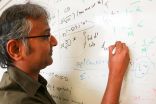(Press-News.org) New Internet-based technology may aid criminal justice agencies through tools such as better criminal databases, remotely conducted criminal trials and electronic monitoring of parolees in the community, according to a new RAND Corporation study.
Top criminal justice priorities for new Internet tools include developing a common criminal history record that can be shared across agencies, developing real-time language translation tools and improved video displays for law enforcement officers to adapt to changing needs, according to the analysis.
"The criminal justice field has mostly been reactive to new technology developments such as smart phones and social media," said John S. Hollywood, lead author of the report and a senior operations researcher at RAND, a nonprofit research organization. "We've developed a road map of how new Internet-based technologies might help law enforcement in the future, as well as set priorities for the improvements that are needed most."
Researchers say that while there are many promising technologies that could aid the criminal justice field, many of the developments raise issues related to civil rights, privacy rights and cybersecurity that must be addressed before the improvements can be fully realized.
The RAND report is based upon feedback from an expert panel of 16 practitioners and technology experts convened to discuss what upcoming Internet technologies may be valuable and what the technology likely will do for criminal justice efforts.
The panel included members from groups such as International Association of Chiefs of Police and the American Probation and Parole Association, as well as technology experts from groups such as IBM and the Electronic Frontier Foundation.
The report outlines an array of scenarios where Web-enabled technology may aid those in the criminal justice system. For example, in the future, police officers may be able to gesture at a self-driving car to bring it to a stop or move a self-driving vehicle that blocks a fire hydrant.
The top law enforcement priority was for help with policies and procedures to interact with driverless vehicles.
"Just how will an officer signal instructions to self-driving cars, such as when officers are controlling traffic at intersections?" Hollywood said. "This and many other questions about law enforcement and driverless vehicles need to be addressed."
Another priority identified by the panel was the creation of a criminal record that integrates information from multiple agencies.
"Criminal records today are incomplete and the records we do have are generally based locally," Hollywood said. "What we need is an ability to get information about a person's criminal history quickly and reliably, even when they move across city or state lines."
Panel members also endorsed improving education across the criminal justice system about key Web-enabled technologies such as sensors and video conferencing. In addition, there is a need for better high-speed Internet connections across the system in order to make use of the new tools.
Other specific law enforcement priorities include biometric sensors that police or correction officers could wear to monitor heartbeat and other vital signs, automatically calling for help if monitoring suggests an officer has been injured or is having a heart attack.
For courts, technology may be able to help ease case backlogs by making it possible for witnesses to testify remotely or even have whole trials done remotely. Better electronic scheduling also could improve the operation of courts.
Jails and prisons could be aided by improved Internet connectivity that allows prisoners to stay in touch with community service providers and parole officers prior to their release. Setting up video connections to prisoners was the top-ranked need from the panel. Technology also could make house arrest more secure, thereby keeping low-level offenders from being sent to crowded jails.
Despite the optimism, the panel of experts said the technologies envisioned raised issues related to both civil and privacy rights. Standards must be agreed upon that enable use of the technologies, while also assuring that they are not used inappropriately, such as to monitor lawful activities.
"There needs to be agreed upon limits on some of the technologies so that they are not used to limit the privacy and civil rights of innocent people," Hollywood said. "In addition, there need to be security standards to make sure that as more information is collected, the information is adequately protected from hacking."
INFORMATION:
The study, "Using Future Internet Technologies to Strengthen Criminal Justice," can be found at http://www.rand.org. Other authors of the study are Dulani Woods, Richard Silberglitt and Brian A. Jackson.
The study is part of the Priority Criminal Justice Needs Initiative, a multiphase project RAND is conducting for the National Institute of Justice to assess and prioritize technology needs across the criminal justice community. Other reports have explored topics such as digital evidence and information technology in criminal justice.
Funding for the study was provided by the Office of Justice Programs at the National Institute of Justice.
The project was conducted within the RAND Safety and Justice Program, which conducts public policy research on corrections, policing, public safety and occupational safety.
During the deer's breeding season, or rut, the researchers from Queen Mary University of London (QMUL) and ETH Zürich, played male fallow deer (bucks) in Petworth Park in West Sussex, a variety of different calls that had been digitally manipulated to change the pitch and length and analysed their responses. The bucks treated lower pitched and longer calls as more threatening, by looking towards source of the call sooner and for longer, than others.
Fallow bucks attracted the attention of the researchers because of their intriguing calling behaviour. Males are silent ...
BOSTON, Aug. 16, 2015 -- Sunlight can be brutal. It wears down even the strongest structures, including rooftops and naval ships, and it heats up metal slides and bleachers until they're too hot to use. To fend off damage and heat from the sun's harsh rays, scientists have developed a new, environmentally friendly paint out of glass that bounces sunlight off metal surfaces -- keeping them cool and durable.
The researchers present their work today at the 250th National Meeting & Exposition of the American Chemical Society (ACS). ACS, the world's largest scientific ...
Findings from Nationwide Children's Hospital physicians demonstrate that headaches increase in fall in children, a trend that may be due to back-to-school changes in stress, routines and sleep. Although it may be difficult for parents to decipher a real headache from a child just wanting to hold onto summer a little longer and avoid going back to school, there is a variety of other common triggers including poor hydration and prolonged screen time that could contribute to a child's discomfort.
"When we saw many of our families and patients in clinic, the families would ...
BUFFALO, N.Y. - Medicare Part D provides help to beneficiaries struggling with the cost of prescriptions drugs, but the plan's coverage gap hits some populations harder than others, particularly African-Americans age 65 and older. Reaching, or even approaching, the gap affects access to medication and influences whether those medications are taken as prescribed.
"Don't assume that the existence of Part D means that people aren't having a difficult time affording their meds," says Louanne Bakk, an assistant professor in the University at Buffalo School of Social Work. "There ...
SALT LAKE CITY, Aug. 14, 2015 - Software may appear to operate without bias because it strictly uses computer code to reach conclusions. That's why many companies use algorithms to help weed out job applicants when hiring for a new position.
But a team of computer scientists from the University of Utah, University of Arizona and Haverford College in Pennsylvania have discovered a way to find out if an algorithm used for hiring decisions, loan approvals and comparably weighty tasks could be biased like a human being.
The researchers, led by Suresh Venkatasubramanian, ...
Discovered in 1982, Helicobacter pylori (H. pylori) is a disease-causing bacterium that survives in our stomachs despite the harsh acidic conditions. It is estimated that one in two people have got it, though most won't ever experience any problems. Even so, it is considered one of the most common bacterial infections worldwide and a leading cause of dyspepsia, peptic ulceration and gastric cancer.
Through unique evolutionary adaptations, H. pylori is able to evade the antiseptic effect of our stomach acid by hiding within the thick acid-resistant layer of mucus that ...
Washington, DC - August 14, 2015 - Tungsten is exceptionally rare in biological systems. Thus, it came as a huge surprise to Michael Adams, PhD., and his collaborators when they discovered it in what appeared to be a novel enzyme in the hot spring-inhabiting bacterium, Caldicellulosiruptor bescii. The researchers hypothesized that this new tungstoenzyme plays a key role in C. bescii's primary metabolism, and its ability to convert plant biomass to simple fermentable sugars. This discovery could ultimately lead to commercially viable conversion of cellulosic (woody) biomass ...
What happens when a drought in Florida estuaries causes a rise in the salt levels in water? Fewer wild oysters appear on restaurant menus, for starters.
New research from Northeastern University marine and environmental sciences professor David Kimbro and graduate student Hanna Garland, published in PLOS ONE, links the deterioration of oyster reefs in Florida's Matanzas River Estuary (MRE) to a population outbreak of carnivorous conchs and ...
OAK RIDGE, Tenn., Aug. 14, 2015 - Another barrier to commercially viable biofuels from sources other than corn has fallen with the engineering of a microbe that improves isobutanol yields by a factor of 10.
The finding of the Department of Energy's BioEnergy Science Center, published in the journal Metabolic Engineering, builds on results from 2011 in which researchers reported on the first genetically engineered microbe to produce isobutanol directly from cellulose.
Isobutanol is attractive because its energy density and octane values are much closer to gasoline and ...
Americans favor diplomatic and economic strategies over military involvement in foreign policy, according to a new national survey conducted by The Associated Press-NORC Center for Public Affairs Research. Americans also question whether or not the United States should be the world's chief problem solver, even as a myriad of issues across the globe are identified as important for the next president to address. The nationwide poll of 1,167 adults collected data from June 25 to July 7 using AmeriSpeak, the probability-based panel of NORC at the University of Chicago. Interviews ...


